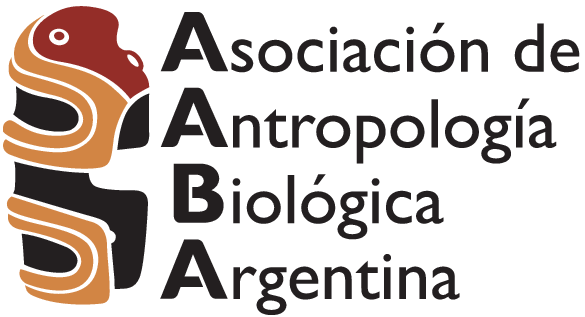Estimadores anatómicos y edad a la muerte: II. Resultados de su análisis estadístico en esqueletos adultos del sitio SJ til. 43. (Tilcara, Jujuy)
Resumen
RESUMEN Este trabajo, continuación de uno anterior (Barboza et al., 2001), utiliza la información obtenida a partir de la aplicación de un conjunto de técnicas basadas en la observación y registro de marcadores osteomorfológicos (craneales y pélvicos) de edad sobre materiales osteológicos procedentes del sitio SJ Til. 43 (Tilcara, Jujuy) cronológicamente asignables al Período Hispano-Indígena (AD 1500-1600). Con el objeto de analizar el comportamiento de las asignaciones dentro de cada rango de edad considerado, se realizó el tratamiento estadístico inferencial (ANOVA) sobre los datos correspondientes a los individuos adultos exclusivamente (n:17). Nuestra experiencia permite observar que la aplicación rigurosa de técnicas consideradas convencionales arroja diferencias significativas entre las estimaciones, según la categoría de edad considerada. Esta circunstancia nos lleva a advertir que se deben tomar todos los recaudos necesarios para evitar la utilización indiscriminada de las mismas, particularmente cuando se trata de su aplicación a materiales de origen arqueológico. Los resultados son interpretados en función de los referentes teóricos de la biología del crecimiento y desarrollo y en la necesidad de focalizar la atención en los aspectos vinculados con la biología de la senescencia del sistema esqueletal humano.
ABSTRACT We present here the results of an experience using a set of conventional morphological aging techniques on a sample of seventeen adult skeletons from La Falda Cemetery (SJ Til. 43, Tilcara, Jujuy Province, NW Argentina), belonging chronologically to the Native-Spanish Period (AD 1500-1600). Our techniques are based upon the observation and registration of osteomorphological age markers (cranial and pelvic), and represent a continuation of the research by Barboza et al. (2001). Our objective is to reexamine the variations in the adult estimated age range between different techniques and to apply statistical inferential values (Analysis of Variance). We have discovered a significant and problematic variation in age estimates obtained by various approaches. Our observations and results call particular attention to the inconsistent results derived from the indiscriminate use of approaches, techniques, and methods, particularly when working with archaeological skeletal samples. Our results are interpreted in terms of the biology of development and growth, and stress a need to focus upon the biology of senescence of the human skeletal system.
Descargas
Referencias
Barboza MC (1999) Estudio de Marcadores Biológicos del Sexo y la Edad en una Colección Osteológica (SJ Til. 43) del Hispanoindígena Inicial Tilcareño. Tesis de Licenciatura Inédita. Universidad Nacional de Rosario.
Barboza MC. Mondonga OJ y Bordach MA (2001) Estimadores anatómicos y edad a la muerte: resultados de su aplicación a los materiales del Sitio SJ Til. 43. (Tileara Jujuy). Rev. Arg. Antrop. Biol. 3(l):49-63.
Barboza MC, Mendonga OJ y Bordach MA (2002) Contexto arqueológico y biología esqueletal humana. Actas del XIII Congreso Nacional de Arqueología Argentina Tomo II: 339-343.
Bordach MA (19X5) La determinación de la edad en el esqueleto humano. Revista Comcchingonia.
Bordach MA. Mendonga OJ. Ruiz MS y Albeek ME (1997) El Señor de La Falda: indicadores de una persona social en el Tileara Hispanoindígena. En: Cremonte MB (comp): Los Desarrollos Locales y sus Territorios. Argentina, Universidad Nacional de Jujuy. pp. 199-208.
Brooks ST (1955) Skeletal age at death: the reliability of cranial and pubic age indicators. Am. J. Phys. Anthropol. 13:567-597.
Brooks ST y Suchey JM (1990) Skeletal age determination based on the Os Pubis: a comparison of the Acsádi and Nemeskéri and Suehey-Brooks Methods. Hum.Evol. 5:227-238.
Buikstra JE y Mielke JH (1985) Demography. Diet, and Health, En: Gilbert RI y JH Mielke (eds): The Análisis of Prehistoric Diets, pp, 191-223.
Buikstra JE y Ubelaker DH (1994) Standards for Data Collection from Human Skeletal Remains. Arkansas Archeological. Serie 4.
Gilbert BM (1973) Misapplication to female of the standard foraging the male Os Pubis, Am. J. Phys. Anthropol. 38:39-40.
Gilbert BM y McKern TW (1973) A method for aging the female Os Pubis. Am. J. Phys. Anthropol. 38:31-38.
Grosso MV, Mondonga OJ, Bordach MA y Cappone MA (2002) Identificación de semillas en el cementerio de La Falda (SJ Til, 43), Flotación, Segunda Parte. Actas del XIII Congreso Nacional de Arqueología Argentina. Tomo 11:455-466.
Iloppa RD (2000) Population variation in osteológica! aging criteria: an example from (he Pubie Symphysis. Am. J, Phys. Anthropol. 111:185-191.
Katz D y Suchey JM (1986) Age determination of the male Os Pubis. Am. J. Phys. Anthropol. 69:427-435.
Kutz D y Suchey JM (1989) Race differences in pubis symphyseal aging patterns in the male. Am. J. Phys. Anlhropoh 80:167-172.
Lovejoy CO, Meindl RS, Mensforth RP y Barton TJ (1985a) Multifaetorial determination of skeletal age at death: a method and blind tests of its accuracy. Am. ,1. Phys. Anthropol. 68:1-14.
Lovejoy CO, Meindl RS, Pryzbeck TR y Mensforth RP ( 1985b) Chronological metamorphosis of the aurieular surface of the ilium: a new method for the determination of adult skeletal age at death. Am. J. Phys. Anthropol. 68:15-28.
Me Kern TW y Stewart TD (1957) Skeletal Age Changes in Young American Males. Headquarters. Quartermaster Research and Development Command, Technical Report. HP-45. Quartermaster Research and Development Center, US Army. Natick, Massachusetts.
McKern T (1976) Sexual dimorphism in the maturation of the human pubic symphysis, hn: Giles H (ed): The Measures of Man. Methodologies in Biological Anthropology. Cambridge. Peabody Museum Press, pp. 433-450.
Meindl RS y Lovejoy CO ( 1985) Hctoerunial suture closure: a revised method for the determination of skeletal age at death based on the lateral anterior sutures'. Am. .1. Phys. Anthropol. 68:57-66.
Meindl RS, Lovejoy CO y Mensforth RP ( 1980) Multifaetorial determination of skeletal populations of known age. Am. J. Phys. Anthropol. 52:255.
Meindl RS, Russel KFy Lovejoy CO ( 1990) Reliability of age at death in the Hamann-Todd Collection. Validity of subselection procedures used in blind tests of the summary age technique. Am. J. Phys. Anthropol. 83:349-357.
Meindl RS. Lovejoy CO. Mensforth RP y Walker RA ( 1985) A revised method of age determination using the Os Pubis whit a review and tests of accuracy of other currents methods of pubic symphyseal aging. Am. J. Phys. Anthropol. 68:29-45.
Mendonçao J, Rordach MA, Albeek MH y Ruiz M ( 1997) Col lares de vidrio y ollas de barro. Comportamiento ante la muerte en el Tilcara Hispano indigen a Tnicial (Jujuy, Argentina). Tac. H y Cs. Sociales UNJu. Cuadernos 9:175-202.
Pheniec TW ( 1967) A newly developed visual method of sexing the Os Pubis. Am. J. Phys. Anthropol. 30:297-302.
Stewairt TD ( 1957) Distortion of the pubic symphyseal surface in females and its effects on age determination. Am. J. Phys. Anthropol. 15:9-18.
Stewart TD (1979) Hssenlials of Forensic Anthropology. Springfield, C.C Thomas.
Suchey JM (1979) Problems in the aging of female using the Os Pubis. Am. J. Phys. Anthropol. 51:467-470.
Suchey JM. Wisley DV y Katz D (1986) Evaluation of the Todd andMcKern-Stewarl methods for aging the male Os Pubis. En: Forensic Osteology. Advances in the Identification of Human Remains. Illinois, C Thomas Publisher, pp. 33-67.
Thompson DD (1982) Forensic Anthropology. A History of American Physical Antropology, 1930-1980. pp.357-369.
Todd TW ( 1920) Age changes in the pubic bone I. The male white pubis. Am. J. Phys. Anthropol. 3:285-334.
Todd TW ( 1921 ) Age changes in the pubic bone. II: Pubis of the Male Negro-White hybrid. Ill: Pubis of White Female. IV: Pubis of Female Negro-White hybrid. Am. .1. Phys. Anthropol. 4:1-70.
Todd TW y Lyon DW (1924) Endocraneal suture closure. Its progress and age relationship. Part I. Adult males of white stock. Am. J. Phys. Anthropol. 7:326-384.
Ubclaker DH (1974) Reconstruction of Demographic Profiles from Ossuary Skeletal Samples. A Case Study from The Tidewater Potomac. Washington, Smithsonian Institution, N° 18.
Ubelaker DH (1980) Human Skeletal Remains. Excavation, Analysis, Interpretation. Washington, Smithsonian Institution.
Descargas
Publicado
Número
Sección
Licencia
La RAAB es una revista de acceso abierto tipo diamante. No se aplican cargos para la lectura, el envío de los trabajos ni tampoco para su procesamiento. Asímismo, los autores mantienen el copyright sobre sus trabajos así como también los derechos de publicación sin restricciones.






























